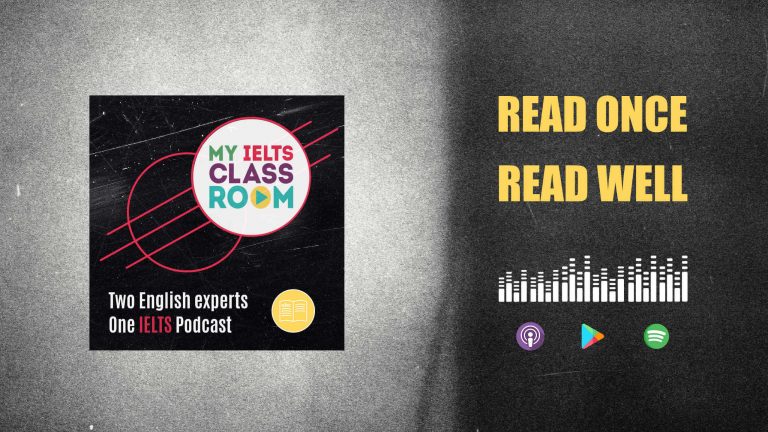
Read Once, Read Well for IELTS reading time management
Read Once, Read Well for IELTS reading time management
Do you struggle with IELTS reading time management? Do you use scanning and skimming but still find that you run out of time? Do you find some types of question very difficult and can never find the right answer (particularly headings match, MCQ’s and information match)? Is your neck sore by the end of the exam from looking back and forth and back and forth from the questions to the passage and back again? Well, this is the podcast episode for you!
About a year ago, I realised that the way IELTS teachers teach reading is not the way that they actually read themselves. This happened when I was completing Cambridge 15 (Academic). After finishing 2 full tests, I was suddenly aware that
- I had not scanned for key words – it had been quicker to read and understand than to try to piece together information in small chunks
- I had been answering all of the questions simultaneously – I mean, why wait to answer the summary at the end of the test when the paragraph with the answers appears in the middle?
- It was taking me only 5 minutes to complete each section because I was answering the questions “naturally” instead of following my own teaching advice!
From that day forward, I totally revolutionised the way that I teach reading. It didn’t happen overnight, but within a few months, I had advised a system that I christened “Read Once, Read Well”.
A system that I have found not only helps students improve their score (because they are actually reading now and understanding the passage) but also makes it much easier to finish the exam on time. So, if you think that IELTS reading time management is a problem for you, why not give it a go?
Below, you can find a summary of the episode, which includes all of the links to useful materials and the times of each part of the discussion (so you can go directly to the part you want to listen to) 🚀
Subscribe to My IELTS Classroom podcast on Apple podcasts here ![]()
![]() Subscribe to My IELTS Classroom on Google podcasts here
Subscribe to My IELTS Classroom on Google podcasts here
Podcast Summary: IELTS reading time management
Let’s start with a short review of the basics of IELTS reading by doing a short quiz (we will give the answers in the podcast – so listen to find out!):
- On your test day, when will you do the reading test – 1st, 2nd, or 3rd?
- How long is the reading test?
- Do you have extra time to transfer your answers to the answer sheet at the end of the test?
- How many sections does the IELTS reading test have?
- How many questions will you have to answer in total?
- How many passages will you have to read in order to answer the questions in the Academic and General Training tests (the answers are different!)?
- We think that there are 14 possible types of question that you may be asked to answer in the exam (although there are less for the GT exam). Can you name them?
If you are new to IELTS and would like to find out more about the basics of the IELTS reading exam, why not go back and listen to our Introduction to IELTS Reading episode?
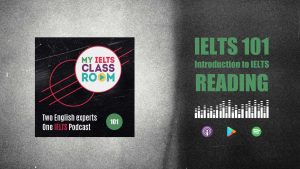
Why do test-takers struggle with IELTS Reading Time Management?
I think that the main complaint of most IELTS test-takers is that they are not able to answer the 40 questions accurately inside an hour. I have lost count of the time that students have told me that they can answer all of the questions in 80 or 90 minutes but not 60. This is often an indication that the students have the level of language needed to get a high score but not the academic reading skills.
Sadly, most of the time this is because they are relying on just ONE academic reading skill: scanning. Now, while skimming and scanning are valid skills that may help you answer some of the questions in the exam, they absolutely cannot help you to answer ALL of the questions, and relying on these techniques can actually make your reading SLOWER.
Now, when I tell this to students, they are often sceptical. I mean, almost every teacher online preaches that the key to reading quickly is to skim and scan. Are those teachers all wrong? Well, yes and no. Let me explain.
1. Not all questions can be answered using key words
Questions that can be answered using scanning are those that
- contain key words that you can quickly identify in the passage
- focus on the understanding of just ONE or TWO sentences in the passage
Take for example True, False, Not Given questions. These are the classic “scanning questions”. You can almost always find a clear unique noun in the question to scan for in the passage, and when you find that word, you can almost always determine the answer from the sentence that contains it. This makes sense as the whole purpose of T/F/NG questions is to test your understanding of specific sentence in the passage.
However, not all questions focus on understand the meaning of a specific sentence
Heading match questions, for example, text your ability to summarise the main idea of a passage. This cannot be found in a key word. In the same way, Information Match questions ask you to identify the function of sentences, and multiple choice questions very often ask you to follow an argument throughout an entire paragraph.
Trying to answer these questions by scanning is like trying to open a door with the wrong key
Therefore, there is simply no avoiding the fact that to have a chance of answering Headings Match, Information Match, and Multiple Choice questions, you have to be prepared to read the WHOLE PARAGRAPH.

Not doing so will mean that you are essentially guessing, and this is why the number one reason why students struggle answering these questions is that they are simply not reading enough! This is why at My IELTS Classroom, we call these questions SLOW QUESTIONS i.e. you cannot use scanning to answer them:
| Can Scan = QUICK 🚀 | Difficult to scan = MEDUIM | Can't Scan = SLOW 🐢 |
|---|---|---|
| T / F / NG Questions | Yes / No / NG Questions | Heading Match Questions |
| Short Answer Questions | Matching Sentence Endings Questions | Information Match Questions |
| Completion Questions | Multiple Choice Questions | |
| Box Matching Questions |
Note that we have a third category here “medium questions”. That is because although Yes, No, Not Given and Matching Sentences Endings are often answered from ONE sentence, they questions rarely have clear scanning words. We will discuss his further in the episode.
2. Scanning often leads to confusion as you have no context for the sentence you read
Even if a question can be answered scanning, when you skip over two or three sentences, you can easily lose the “thread” of the text. Actually, this is my main problem with the scanning method. If you are a native speaker, you many be able to join a conversation in the middle and infer what is being discussed but that is much harder than being there and listening from the beginning.
This is also true in reading. The passages in the Academic reading are long and focus on difficult topics. If you read the passage from the beginning and focus on the understanding the MEANING of the text, you will find that answering the questions becomes relatively simple as you have already processed the information.
However, if you scan over sentences and then try to answer the question, you can easily become confused. The questions feel more like a word puzzle than a test of your actual reading ability. In other words, you are trying to read and understand complex sentences with no context and no understanding of the main arguments being given in the text.
The result? You will simply get questions wrong.
Let me give you this question as an example. It is a very simple one but serves as a good illustration.
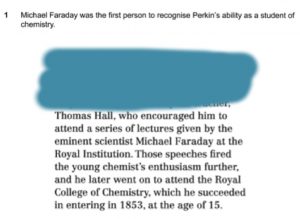
When I ask students to scan for this question, they usually find “Michael Faraday” in the text; go back to the start of the clause and shout “Not Given”. However, when I ask them to read the passage from the start, they almost always groan and say “False”
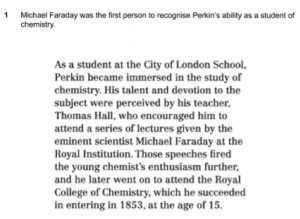
These are the same students, with the same level of English – the only different is that once they READ the passage, they find the answers!
So, we can see that scanning and skimming is often what leads students to becoming confused – some of the questions just can’t be answered in this way, and even the ones that can become more complex as you are looking at disjointed sentences and may be missing synonyms. In other words, the skill that is supposed to be saving you time is actually wasting it.
Would you like expert help to improve your IELTS reading score?
We offer a 5-day intensive course for IELTS test-takers every month that covers all aspects of reading from how to approach every type of question to how to “read one, read well” to manage your time more effectively. Even better, with every course having no more than 8 students and being run by an ex-examiner, you will be getting personalised advice that is guaranteed to help you to improve your score.
Find out more about the course and how it can help you hit your target score here.
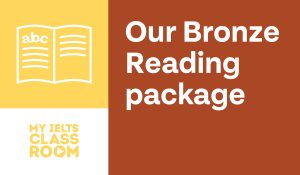
The Reading Questions cannot always be answered in order
The other major problem with IELTS Reading Time Management is how many times students have to read a passage in order to answer all 13 or 14 questions. Yes, in some sections you will be able to start with the first question and work your way through the questions in order, but for many you cannot.
For example, in General Training Section 1, you can start at question 1 and then answer, 2, 3, 4, 5, and 6 in that order as you read. The same is true for all questions in Sections 1 and 2.
The same is also usually true in Academic Reading Section 1, with the questions following the order of the text:
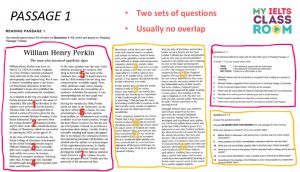
However, in Section 3 of the General Training Test and Sections 2 and 3 of the Academic test, you will find that starting from the first question and working to the last will mean that you will have to go back and read sections of the text two or three times. That is time consuming and, again, pushes students to rely on scanning, which we have already shown to be ineffective.
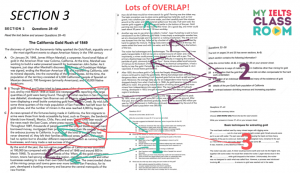
Read Once, Read Well for better IELTS Reading Time Management
So, if we can agree that scanning is not a helpful skill for most questions, and that for the more difficult sections, the questions cannot be answered in order, what is a better approach?
Well, clearly, we do not want to focus on one set of questions at a time as this will mean going back and reading the same parts of the passage more than once. This is time consuming and confusing. Plus, we want to read for meaning i.e. we want to start at the beginning and process what we read though skipping over sections.
In other words, what we want to do is read once, read well.
Now, I do NOT mean that we will read all of the text slowly and then answer the questions – that would be a disaster! No, it means we will start reading from Paragraph A and answer ALL the questions that we can from that paragraph before moving on to the next. Then, we will read Paragraph B and answer all of the questions from that paragraph before moving on to the next. Using this approach, we will read every paragraph only once (so we won’t waste time going back and forward) but we will read for meaning. That is what is lost with all the skimming and scanning. People see the passage as 13 questions and not one text with meaning. Once you start to read and understand the message in the text, answering the questions becomes so much easier.
What do I need to know to Read Once, Read Well?
Not much to be honest. All you need to know is some basic information about the different types of question. First, you just need to know which questions appear in order and which can appear in any paragraph.
- Questions which always appear in order in the passage: T/F/NG, Y/N/NG, Short answer questions, Matching Sentence Endings, Multiple Choice, Completion question (except diagram)
- Questions which can appear anywhere in the passage: Headings match, Information Match, Box Matching
When questions appear in order in the passage, you only need to focus on the FIRST question in the set when you start reading Paragraph A (as they appear in order). When questions can appear in anywhere in the passage, you will need to look for ALL of the questions at at the end of Paragraph A. Do you see the logic? It is very simple! Only look for the questions that can logically appear in each paragraph.
The other thing to remember is that you should focus on the slow questions first (as those benefit from more detailed reading) and then go back and look if you can collect any of the quick questions. For example, if you have 7 Headings Match questions and 6 T/F/NG questions, you should read Paragraph A and focus on finding the first heading and then go back quickly to see if you can also answer the first T/F/NG question in that paragraph. Guess what you will need to do that? SCANNING!
However, as you will probably have read the whole paragraph to answer the Headings Match question and have understood it, you will probably know if the answer is there or not.
I cannot tell you how much quicker it is to read in this way. I know because I use this technique myself and can now complete a full exam in roughy 15 minutes. Obviously, I am a native speaker who has a lot of experience teaching IELTS, but the general rule is that a second-language learner should take roughly twice as long to complete a reading passage as a native speaker. If I can do it in 15 minutes, then you can definitely do it in 60!
Have a go this week and let me know what you think in the comments!
